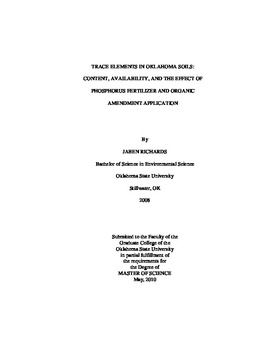| dc.description.abstract | Trace elements in soil are important both for the necessity of some for life and for their potential toxicity when present in elevated levels. Micronutrient availability is important to crop production and can be affected by long-term application of phosphorus (P) fertilizer and other amendments. This study was conducted to determine the effects of the long term application of inorganic and variably sourced organic amendments on micronutrient availability. Extractable (DTPA-sorbitol) and total micronutrients were determined from sites that had long-term application of beef manure, swine effluent, biosolids, or commercial fertilizer across Oklahoma. Three continuous inorganic P experiments that have been conducted for 36 to 39 years and two organic amendment experiments that have been conducted for 11-12 years were evaluated. Soil properties including organic matter, pH, and total soil P were also determined. In the case of micronutrient toxicity, baseline levels need to be established in order to determine the extent of anthropogenic influences to a site. Total trace element levels were determined for 28 benchmark soils of Oklahoma and path analysis was used to determine relationships between these trace element levels and the soil properties pH, OC, clay content, CEC, Alox and Feox. Different relationships were observed between DTPA-extractable micronutrients and total P for different P sources. Significant relationships (p < 0.01) were found between DTPA-extractable Cu, Zn, Fe, and Mo and total P applied in the biosolids amended plots. For the beef manure plots, significant relationships existed between DTPA-extractable B, Fe, Zn, Cu, and Mn and total P applied. Significant relationships were also found between extractable B, Zn, and Cu and total P applied for the swine effluent plots. However, significant relationships were not found between the vast majority of inorganic commercial P fertilizer treatments and DTPA-extractable micronutrients. Long-term application of organic amendments increased micronutrient availability, but long-term application of inorganic P had no effect on micronutrient availability. Trace element concentrations varied in Oklahoma soils. The trace elements Cd, Cr, Cu, Ni, Pb, and Zn were significantly correlated with clay content while Mn was correlated with Alox. | |
